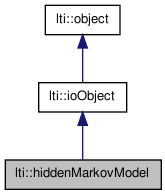

|
latest version v1.9 - last update 10 Apr 2010 |
|
Hidden Markov Model (HMM) class. More...
#include <ltiHiddenMarkovModel.h>


Classes | |
| class | singleDensity |
| This class represents a single multivariate (ie multidimensional ) score density function within a state of a hidden markov model. More... | |
Public Types | |
| enum | scoreType |
| typedef std::vector < singleDensity > | mixtureDensity |
| typedef std::vector < mixtureDensity > | stateList |
Public Member Functions | |
| hiddenMarkovModel () | |
| hiddenMarkovModel (const hiddenMarkovModel &other) | |
| virtual | ~hiddenMarkovModel () |
| hiddenMarkovModel & | copy (const hiddenMarkovModel &other) |
| hiddenMarkovModel & | operator= (const hiddenMarkovModel &other) |
| const char * | getTypeName () const |
| int | getNumberOfStates () const |
| virtual bool | write (ioHandler &handler, const bool complete=true) const |
| virtual bool | read (ioHandler &handler, const bool complete=true) |
Public Attributes | |
User defined | |
| std::string | name |
| dvector | featureWeights |
| double | emissionScoreWeight |
Generated by hmmTrainer | |
These members are usually estimated over a given data set by an automatic training algorithm (see hmmTrainer) | |
| scoreType | scoreFunction |
| stateList | states |
| int | featureDimension |
| dvector | initialScore |
| dmatrix | transitionScore |
Static Public Attributes | |
| static const double | INFINITE_NUMBER |
Hidden Markov Model (HMM) class.
A HMM can be created using the class hmmTrainer, which estimates the HMM parameters A, B, Pi. These stand for the transitions the emissions in the model states, and the initial probabilities.
For an introduction see: L. Rabiner and B.-H. Juang, "An introduction to hidden markov models", IEEE ASSP Magazine no.1, vol.3, pp4-16, 1986.
For computational efficiency probabilities p are not explicitly computed but represented by scores (~ -ln(p)). Note that a high score corresponds to a low probability, i.e. it rather resembles a cost.
| typedef std::vector<singleDensity> lti::hiddenMarkovModel::mixtureDensity |
A mixture density.
Composed of single densities to represent the distribution within one state
| typedef std::vector<mixtureDensity> lti::hiddenMarkovModel::stateList |
States of the model, where each state contains a mixture density.
Density type used.
Currently gauss or laplace are available.
| lti::hiddenMarkovModel::hiddenMarkovModel | ( | ) |
default constructor
| lti::hiddenMarkovModel::hiddenMarkovModel | ( | const hiddenMarkovModel & | other | ) |
copy constructor
| other | the hiddenMarkovModel to be copied |
| virtual lti::hiddenMarkovModel::~hiddenMarkovModel | ( | ) | [virtual] |
destructor
| hiddenMarkovModel& lti::hiddenMarkovModel::copy | ( | const hiddenMarkovModel & | other | ) |
copy data of "other" hiddenMarkovModel.
Please note that the status string will _NOT_ be copied!
Reimplemented from lti::ioObject.
| int lti::hiddenMarkovModel::getNumberOfStates | ( | ) | const |
Returns the number of states of this model.
| const char* lti::hiddenMarkovModel::getTypeName | ( | ) | const [virtual] |
returns name of this type
Reimplemented from lti::ioObject.
| hiddenMarkovModel& lti::hiddenMarkovModel::operator= | ( | const hiddenMarkovModel & | other | ) |
assigment operator (alias for copy(other)).
| other | the hiddenMarkovModel to be copied |
Reimplemented from lti::ioObject.
| virtual bool lti::hiddenMarkovModel::read | ( | ioHandler & | handler, | |
| const bool | complete = true | |||
| ) | [virtual] |
read the parameters from the given ioHandler
| handler | the ioHandler to be used | |
| complete | if true (the default) the enclosing begin/end will be also written, otherwise only the data block will be written. |
Reimplemented from lti::ioObject.
| virtual bool lti::hiddenMarkovModel::write | ( | ioHandler & | handler, | |
| const bool | complete = true | |||
| ) | const [virtual] |
write the parameters in the given ioHandler
| handler | the ioHandler to be used | |
| complete | if true (the default) the enclosing begin/end will be also written, otherwise only the data block will be written. |
Reimplemented from lti::ioObject.
Relative weight of the emission scores compared to the initial and transition score.
Can be used to compensate the magnitude difference between those.
Use a value >1.0, to emphasize the emission or a value <1.0 to put more weight into the transitions. Default value is 1.0
Number of dimensions for an observation.
Absolute weight of each feature (dimension).
Default is a vector of 1.0 for all features to indicate equal importance (weights are ignored if number of dimensions differs from featureDimension).
const double lti::hiddenMarkovModel::INFINITE_NUMBER [static] |
This number is considered to be the "impossible" score (score equivalent to a probability of 0.0).
Score for each state being the starting state.
This is the HMM parameter called Pi
| std::string lti::hiddenMarkovModel::name |
Name of the model.
Can be used to identify a model by a string.
Specifies the score function to be used.
default: laplaceScore
List of states of the model s_i.
Generally the number of states is denoted N. The states contain the emission functions b_i, known as the HMM parameter called B
Score for each transition.
TransitionScore[a][b] is the score for a transition from state a to b. This is the HMM parameter called A